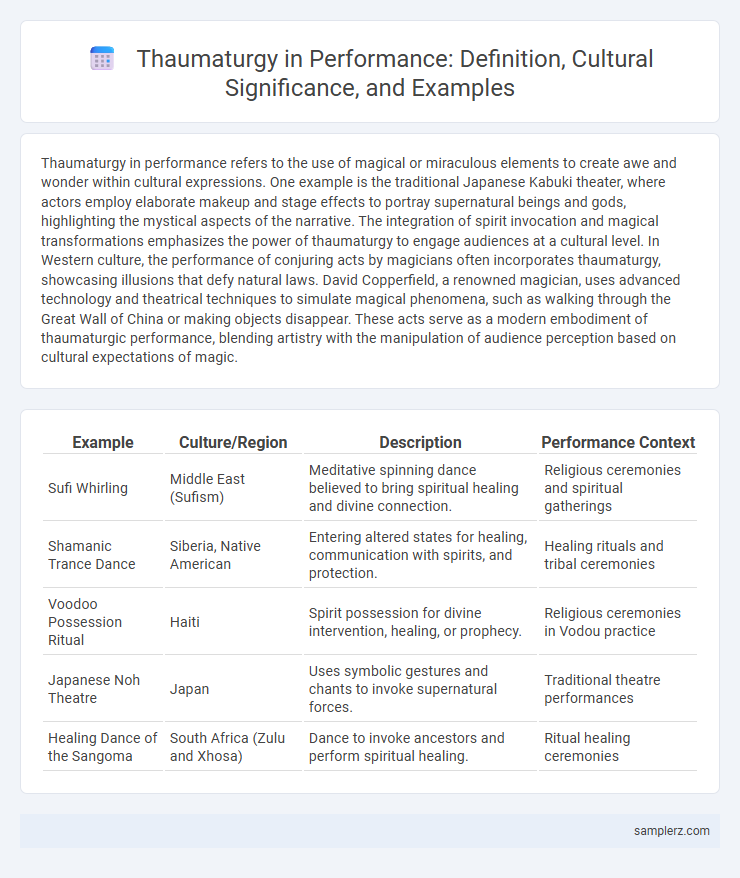Thaumaturgy in performance refers to the use of magical or miraculous elements to create awe and wonder within cultural expressions. One example is the traditional Japanese Kabuki theater, where actors employ elaborate makeup and stage effects to portray supernatural beings and gods, highlighting the mystical aspects of the narrative. The integration of spirit invocation and magical transformations emphasizes the power of thaumaturgy to engage audiences at a cultural level. In Western culture, the performance of conjuring acts by magicians often incorporates thaumaturgy, showcasing illusions that defy natural laws. David Copperfield, a renowned magician, uses advanced technology and theatrical techniques to simulate magical phenomena, such as walking through the Great Wall of China or making objects disappear. These acts serve as a modern embodiment of thaumaturgic performance, blending artistry with the manipulation of audience perception based on cultural expectations of magic.
Table of Comparison
| Example | Culture/Region | Description | Performance Context |
|---|---|---|---|
| Sufi Whirling | Middle East (Sufism) | Meditative spinning dance believed to bring spiritual healing and divine connection. | Religious ceremonies and spiritual gatherings |
| Shamanic Trance Dance | Siberia, Native American | Entering altered states for healing, communication with spirits, and protection. | Healing rituals and tribal ceremonies |
| Voodoo Possession Ritual | Haiti | Spirit possession for divine intervention, healing, or prophecy. | Religious ceremonies in Vodou practice |
| Japanese Noh Theatre | Japan | Uses symbolic gestures and chants to invoke supernatural forces. | Traditional theatre performances |
| Healing Dance of the Sangoma | South Africa (Zulu and Xhosa) | Dance to invoke ancestors and perform spiritual healing. | Ritual healing ceremonies |
Defining Thaumaturgy in Cultural Performance
Thaumaturgy in cultural performance refers to the use of magical or supernatural acts to evoke awe and convey deeper symbolic meanings within rituals and theatrical presentations. This practice often involves illusions, symbolic gestures, and ritualized actions designed to transform the perception of reality and connect audiences with spiritual or mystical themes. Examples include traditional shamanic ceremonies where practitioners perform healings or transformations that bridge the natural and supernatural realms.
Ancient Rituals: Roots of Performance Thaumaturgy
Ancient rituals often employed thaumaturgy as a central element to manifest supernatural power and evoke awe within audiences, blending spirituality with theatricality. Examples include shamanistic ceremonies where performers invoked spirits through symbolic gestures, chants, and ritualistic objects, creating an experience of divine intervention. These foundational practices influenced the evolution of performance thaumaturgy, merging cultural beliefs with dramatic presentation to communicate transcendent realities.
Thaumaturgy in Traditional Theater Arts
Thaumaturgy in traditional theater arts manifests through intricate illusions and magical effects that captivate audiences, such as shadow play in Balinese Wayang Kulit and the transforming masks in Japanese Noh theater. These performances employ symbolic gestures and ritualistic elements to evoke spiritual wonder and convey supernatural narratives. The seamless integration of thaumaturgic techniques enhances the storytelling and reinforces cultural heritage within these theatrical traditions.
Magical Realism on Stage: Modern Interpretations
Magical realism on stage transforms traditional thaumaturgy by blending supernatural elements with everyday reality, creating immersive performances that challenge audiences' perceptions of the natural world. Contemporary theater productions utilize subtle illusions and symbolic gestures to evoke a sense of wonder without overt spectacle, reflecting Latin American literary roots in a live narrative form. This modern interpretation fosters a unique dialogue between cultural mythologies and present-day storytelling techniques, enriching the theatrical experience through layered, mystical realism.
Thaumaturgic Elements in Dance and Movement
Thaumaturgic elements in dance and movement manifest through illusionary gestures, symbolic choreography, and ritualistic expressions that evoke transformation and transcendence. Performers employ mystical motifs and altered states of consciousness to create an otherworldly experience, captivating audiences with metaphysical themes embedded in every step and gesture. These thaumaturgic techniques blend spirituality and artistic expression, turning dance into a powerful medium for enchantment and ritual magic.
Ritual Magic in Religious Ceremonies
Ritual magic in religious ceremonies often employs thaumaturgy to invoke divine intervention or manifest supernatural effects, such as healing, protection, or purification. These performances use sacred symbols, chants, and gestures to create a spiritual atmosphere that facilitates the connection between practitioners and deities. Historical examples include shamanic healing rituals, Catholic exorcisms, and Hindu fire ceremonies where thaumaturgic acts reinforce faith and devotion.
Illusion and Transformation in Street Performance
Thaumaturgy in street performance often manifests through illusion and transformation, captivating audiences by seemingly altering reality in real time. Performers use sleight of hand, mirror tricks, and rapid costume changes to create magical effects that challenge perception and hint at supernatural powers. These acts, rooted in cultural traditions of mysticism and spectacle, exemplify how street thaumaturgy transforms urban spaces into stages of wonder and amazement.
Thaumaturgy in Music and Sound Arts
Thaumaturgy in music and sound arts manifests through immersive sonic environments that evoke wonder and transformation, often using spatial audio techniques and live electronic manipulation. Artists employ harmonic alchemy and psychoacoustic effects to create transcendent experiences that alter perception, merging traditional instrumentation with cutting-edge technology. This fusion of mystical intent and technical innovation exemplifies thaumaturgy's power to transcend ordinary sensory boundaries in contemporary performances.
Cross-Cultural Comparisons of Performance Magic
Thaumaturgy in performance manifests diversely across cultures, exemplified by the Chinese art of bian lian, where rapid mask changes evoke mystical transformation, contrasting with Western stage magic that emphasizes sleight of hand and illusion. In Indian traditional theater, magicians integrate tantric rituals blending spirituality with entertainment, highlighting the cultural fusion of magic and religious symbolism. These cross-cultural variations underscore how thaumaturgy reflects unique societal values and belief systems within performance magic.
Thaumaturgy’s Influence on Contemporary Performance Art
Thaumaturgy, the art of performing miracles or magic, profoundly shapes contemporary performance art by incorporating illusions that challenge perceptions of reality. Artists like Laurie Anderson and Marco Tempest utilize thaumaturgic elements to create immersive experiences that blur the boundaries between technology, narrative, and spectacle. This influence fosters a dynamic dialogue between audience and performer, redefining the possibilities of theatrical expression in modern culture.

example of thaumaturgy in performance Infographic
 samplerz.com
samplerz.com